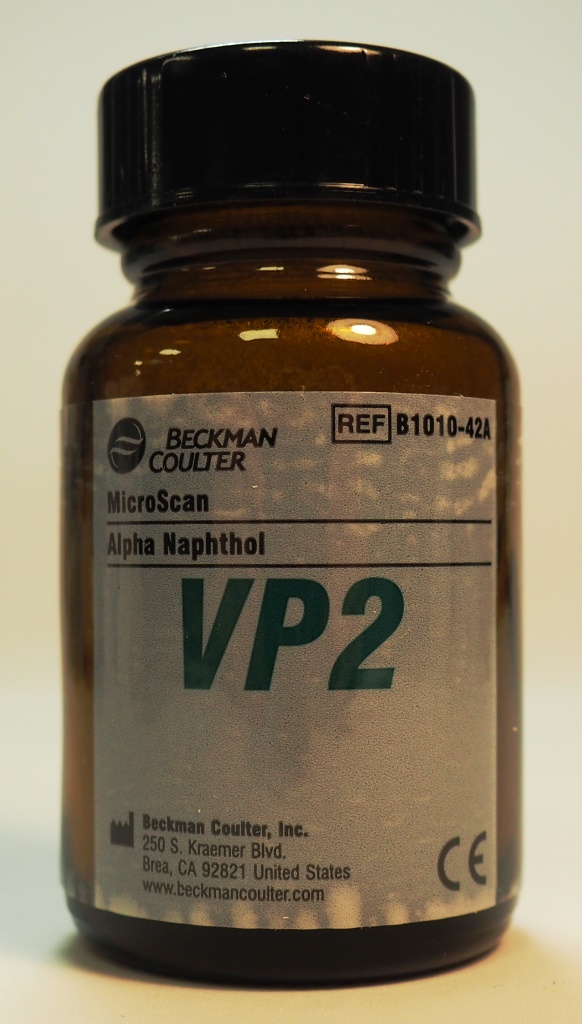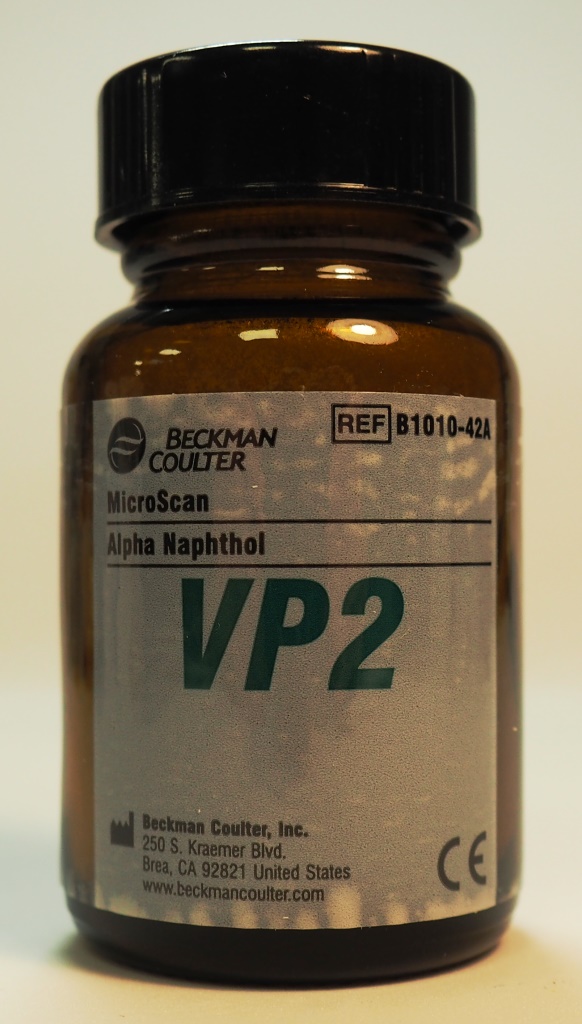ALPHA-NAPHTHOL, 5%, 1.5g, bot. (MicroScan B1010-42A)
Valid Article
ALPHA-NAPHTOL
Definition
Reagent used for Voges-Prosker (VP) test on MSF NEG/POS ID PANEL type 2
Synonym
VP2 reagent (Voges-Proskauer 2 reagent)
Specifications
Technical specifications
- Powder, 1-Naphthol, 1.5g
- CAS n°: 90-15-3
Packaging & Labelling
Glass vial
Transport Dangerous Goods
- UN2811
- Class: 6.1
- Packing group: III
- Proper shipping name: Toxic solids, organic, n.o.s. (1-napthol)
Instructions for use
Dilute with 30 mL 95% Ethyl Alcohol.
Detection of acetoin in the VP well is analysed by adding alpha-naphtol and potassium hydroxide to the broth. A cherry red colour indicates a positive result and the production of acetoin, while a yellow-brown colour indicates a negative result.
Please consult the “Bacteriology laboratory procedures and resources” available online via the Laboratory working Group sharepoint page: Laboratory Procedures and Resources
For offline access, contact your laboratory advisor
Storage
- Store between 15°C and 30°C
- Store away from strong acids, strong bases, strong oxidizers and incompatible materials
- Reconstituted reagent stable for 14 days at 2-30°C
- Shelf life: 12 months
- Guaranteed minimum remaining shelf life at delivery: 1/3 of total shelf life
Waste management
Substance with hazardous characteristics. Please contact your watsan referent for advice on proper disposal.
Detailed hazard and precautionary information can be found in the safety data sheet (SDS).
Classification EC Regulation N° 1272/2008
- Acute Toxicity Oral, Category 4
- Acute Toxicity Dermal,Category 3
- Skin Irritation, Category 2
- Eye Damage, Category 1
- Specific Target Organ Toxicity Single Exposure Category 3
- Aquatic Hazard Longterm, Category 2
Signal Word
Danger
| H302 | Harmful if swallowed |
| H311 | Toxic in contact with skin. |
| H315 | Causes skin irritation |
| H318 | Causes serious eye damage. |
| H335 | May cause respiratory irritation |
| H411 | Toxic to aquatic life with long lasting effects. |
| P405 | Store locked up. |
| P403 + P233 | Store in a well-ventilated place. Keep container tightly closed. |
| P261 | Avoid breathing dust/fume/gas/mist/vapours/spray. |
| P270 | Do not eat, drink or smoke when using this product. |
| P271 | Use only outdoors or in a well-ventilated area. |
| P273 | Avoid release to the environment |
| P280 | Wear protective gloves/protective clothing/eye protection/face protection |
| P310 | Immediately call a POISON CENTER or doctor/physician. |
| P330 | Rinse mouth. |
| P391 | Collect spillage |
| P301 + P312 | IF SWALLOWED: call a POISON CENTER or doctor/physician if you feel |
| P302 + P352 | IF ON SKIN: wash with plenty of soap and water |
| P304 + P340 | IF INHALED: Remove to fresh air and keep at rest in a position comfortable for breathing. |
| P305 + P351 + P338 | IF IN EYES: rinse cautiously with water for several minutes. If the victim wears contact lenses, remove them if possible. Keep rinsing |
| P332 + P313 | If skin irritation occurs: get medical advice/attention |
| P501 | Dispose of contents/container to location in accordance with local and regional/ national/ international regulations |
| P362 + P364 | Take off contaminated clothing and wash it before reuse. |
| P361 + P364 | Take off immediately all contaminated clothing and wash it before reuse |
MSF requirements
Reserved for projects using the Mini-Lab





![[KMEDMBLB02D] (bacteriology Mini-Lab) STARTERKIT, 800 samples, RTR](/web/image/product.template/579047/image_256/%5BKMEDMBLB02D%5D%20%28bacteriology%20Mini-Lab%29%20STARTERKIT%2C%20800%20samples%2C%20RTR?unique=6fb9a30)
![[ELABTEAT1ID] DROPPER for identification reagent (B1013-12A)](/web/image/product.template/578602/image_256/%5BELABTEAT1ID%5D%20DROPPER%20for%20identification%20reagent%20%28B1013-12A%29?unique=3b8f655)
![[SBIDBISSP04] MSF NEG/POS ID PANEL type 2 (C38213)](/web/image/product.template/578606/image_256/%5BSBIDBISSP04%5D%20MSF%20NEG-POS%20ID%20PANEL%20type%202%20%28C38213%29?unique=2acf087)